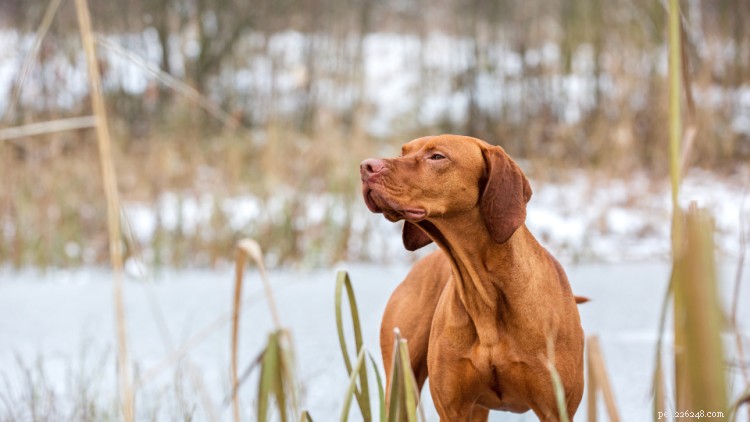Het hebben van een hond kan een leuke ervaring zijn, maar het kan ook behoorlijk stressvol zijn als ze plotseling ziek worden. Dit is vooral het geval als uw huisdier een gezondheidstoestand ontwikkelt waar veel eigenaren niet bekend mee zijn, zoals blastomycose.
Lees meer over de symptomen van deze zeldzame en mogelijk dodelijke schimmelinfectie, evenals de beschikbare behandelingsopties en of er manieren zijn om te voorkomen dat uw hond het oploopt.
Inhoudsopgave:
Pro-tip: Een huisdierenverzekering biedt waardevolle gemoedsrust door ervoor te zorgen dat uw geliefde toegang heeft tot veterinaire zorg volgens de gouden standaard, terwijl uw financiële risico wordt geminimaliseerd als ze een gezondheidsprobleem ontwikkelen, zoals een blastomycose-infectie.
Blastomycose is een schimmelinfectie veroorzaakt door Blastomyces dermatitidis , een schimmel die in de bodem leeft en rottend organisch materiaal (zoals rottende vegetatie). Honden raken meestal besmet na het inademen van schimmelsporen in de omgeving.
Blastomycose treft vooral de longen, ogen en huid . Een verscheidenheid aan andere organen en systemen kan echter ook worden aangetast, waaronder het hart, de botten, het lymfestelsel en het zenuwstelsel. Zonder behandeling kan de ziekte de dood tot gevolg hebben.
In de VS komt blastomycose het meest voor in de mid-Atlantische staten , vooral de warme en vochtige riviervalleien in Ohio, Mississippi, Missouri en Tennessee. Het komt ook voor in de zuidoostelijke staten, de Pacific Northwest en rond de Grote Meren.
Infectie door Blastomyces bij honden komt het meest voor wanneer conidiën, de infectieuze schimmeldeeltjes, worden verneveld. Bepaalde weersomstandigheden, zoals regen, mist en dauw, worden verondersteld deze deeltjes te activeren, die vervolgens worden ingeademd of geabsorbeerd door de huid van de hond. De meeste gevallen van blastomycose bij honden worden gediagnosticeerd in de vroege herfst of de late zomer.
Blastomycose kan honden, katten en mensen treffen, maar honden lijken vatbaarder te zijn. Volgens VCA Dierenziekenhuizen hebben honden ongeveer tien keer meer kans om besmet te raken dan mensen, en 100 keer meer kans dan katten.
Honden van elk ras, leeftijd en geslacht kunnen besmet zijn . Omdat de ziekte echter voorkomt in habitats die worden gekenmerkt door vochtige grond met rottende vegetatie zoals moerassen, worden vogelhonden en wandelgenoten geacht een bijzonder groter risico te lopen als ze in een geografisch gebied wonen waar Blastomyces is aanwezig. Reuen van grote rassen lijken ook vaker geïnfecteerd te zijn.

Onder normale omstandigheden wordt de ziekte niet overgedragen van dier op dier of op mens . Omdat de schimmel echter aanwezig is in de gedeelde omgeving van het geïnfecteerde huisdier en niet-geïnfecteerde familieleden, lopen mensen en andere dieren ook het risico om een infectie door de sporen in de omgeving te ontwikkelen.
Zoals eerder vermeld, wordt blastomycose bij mensen als relatief ongewoon beschouwd. In het zeldzame geval dat directe overdracht optreedt, is het wanneer secreties van een open, drainerende wond bij de hond in contact komen met een open wond bij de mens. Om deze reden, als uw hond besmet is, moet u strikte hygiëneregels volgen bij het behandelen van hun laesies. Draag altijd beschermende handschoenen en was uw handen goed na elk contact met het besmette huisdier. In de meeste gevallen hoeft de besmette hond niet te worden gescheiden van andere leden van het huishouden.
Als u zich zorgen maakt dat u mogelijk bent blootgesteld aan blastomycose of als uw hond is geïnfecteerd, neem dan contact op met uw arts . Dit is vooral belangrijk als uw gezinsleden kleine kinderen, ouderen, chemotherapiepatiënten zijn of een gecompromitteerd immuunsysteem hebben.
Afhankelijk van welk systeem wordt aangetast, kunnen symptomen van blastomycose bij honden zijn:
Bij veel honden treft de ziekte meerdere orgaansystemen . Volgens DVM360 komen ademhalingsproblemen voor bij 65% tot 85% van de getroffen honden. Huidlaesies (open, sijpelende zweren op de neus, mond of voetzolen, puistjes, uitslag-achtige laesies) worden waargenomen bij 30% tot 50% van de hondenpatiënten. Oogsymptomen (blindheid, roodheid van de ogen, loensen) komen ook vrij vaak voor en treffen ongeveer 50% van de geïnfecteerde huisdieren.
Als uw hondgenoot in een omgeving is geweest waar Blastomyces in de zes weken vóór het begin van de klinische symptomen aanwezig zou kunnen zijn, moet u uw dierenarts hiervan op de hoogte stellen, vooral als u naar dit gebied bent gereisd.
Blastomycose kan lastig te diagnosticeren zijn omdat de symptomen vaak niet-specifiek zijn . For instance, infections of the lung can look like cancer on imaging tests, whereas skin lesions can be mistaken for a skin infection.
The best methods for diagnosing the condition include:
Tissue samples might also be taken to check for the presence of fungal organisms. Other tests that might help make a final diagnosis include a urinalysis and an X-ray of the lungs or leg (if the dog is limping). There are also newer specialized tests that can help to identify the fungal organism in the blood and urine.
Blastomycosis is treated with oral antifungal medication (usually fluconazole or itraconazole), which can be quite expensive because of the duration of treatment. The medication must be administered for a minimum of six to eight weeks. In some cases, treatment can require more than one year in order to clear the infection.
In severe cases, the affected dog may need an extended period of hospitalization , especially if they suffer from severe respiratory symptoms. Dogs with dyspnea (severe difficulty breathing) might require supplemental oxygen.
Eye infections can be especially difficult to treat and your vet might refer you to a veterinary ophthalmologist (eye specialist). Topical eye medications can alleviate the discomfort and pain but usually don't help clear the infection.
In some cases, the affected organs need to be removed to eliminate the fungal organism, such as castration for male dogs with orchitis. In dogs who have lost vision due to the ocular form of the disease, the eye(s) might need to be removed to clear the infection. Most dogs do very well following enucleation (removal of the eyes), especially if they had previously lost their sight. In cases of severe bone infection , your pet might need limb amputation.
Canine blastomycosis patients are discharged from the hospital with instructions to administer ophthalmic or oral medications. Topical treatment of skin lesions might also be required.

Pro-tip: The cost of diagnosis and treatment of blastomycosis can be quite high. X-rays, lab work, and biopsy can cost from $500 to $1500, whereas the monthly cost for the long-term antifungal medication can be between $150 and $750. With the right pet insurance plan, you can be reimbursed up to 90% of your vet bills for unexpected illnesses and accidents.
The initial prognosis for dogs with blastomycosis is guarded and depends on the response to treatment. According to the Merck Veterinary Manual, approximately 70% of dogs will reach a clinical cure . The prognosis is better for patients with mild disease at the time of diagnosis.
In most cases, the critical period is in the first 24 to 72 hours of treatment, during which the medication is taking effect. In some cases, a severe inflammatory response might occur as the medication begins to kill off the fungal organisms, resulting in respiratory distress because of the large number of organisms in the lungs.
Even when treatment appears to be successful, there is a risk of relapse that can occur months to years after the initial infection. Up to 20% of dogs who have recovered will experience relapse. Patients with the ocular, nervous system or testicular involvement seem to be at higher risk of relapse.
Follow-up testing of the urine with a urine antigen test is usually recommended in order to determine whether the treatment plan is working. Chest X-rays can be used to help determine response to treatment and reveal any permanent changes in the lungs that might have resulted from the treatment.
There is no vaccine to prevent blastomycosis in dogs . The only thing pet dog owners can do is keep their canine friends away from marshy landscapes, as well as streams and lakes where the risk of exposure is the highest. If you live or spend time in high-risk regions, this will likely be difficult, but you should at least try to stay away from dark, dense areas where the fungus thrives, especially if your pet's immune system is already weakened.